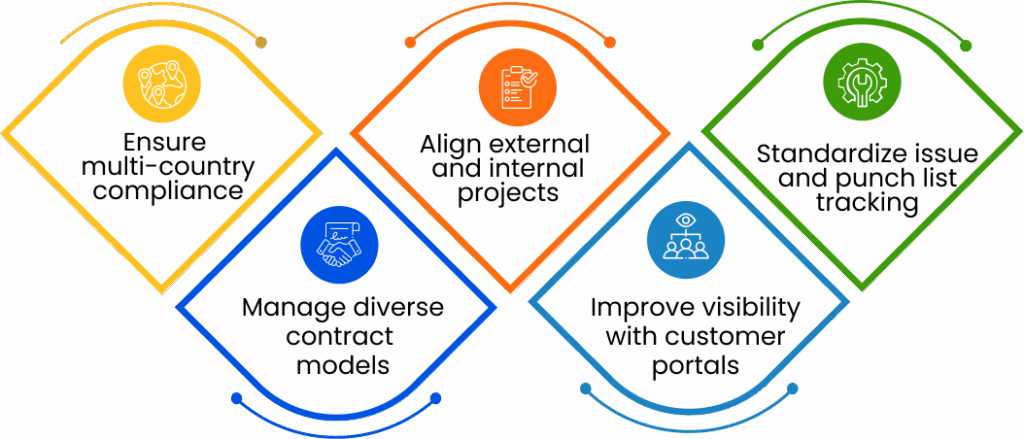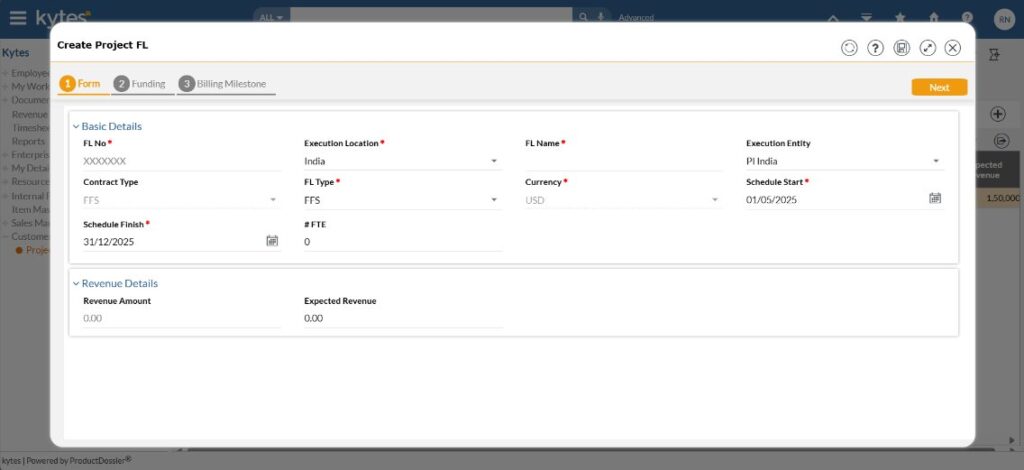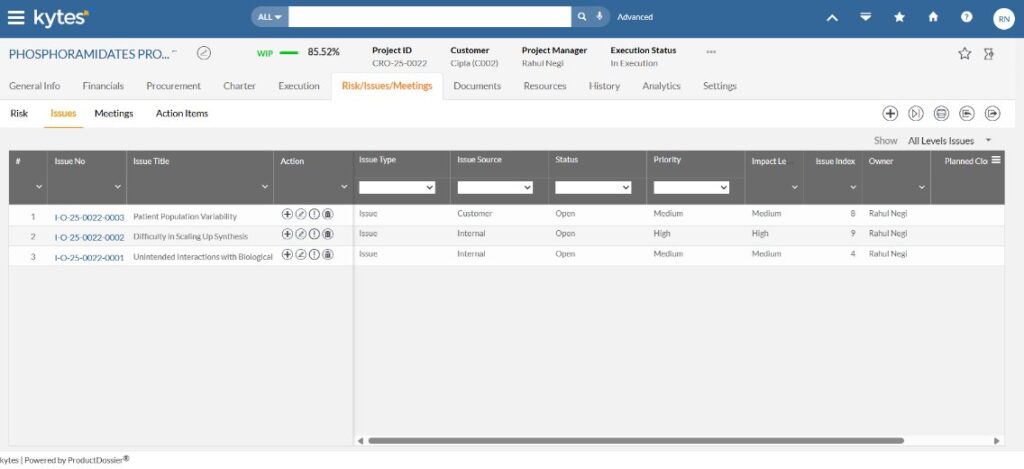As of early 2025, there are over 6,800 pharmaceutical companies with active research and development (R&D) pipelines, comprising approximately 24,000 drugs in the global R&D pipeline.
In such a highly competitive landscape, any disruption can cascade through entire pipelines—costing millions, jeopardizing regulatory filings, and undermining the hard work of teams. To stay ahead of the competition and capitalize on modern advancements and technology, more organizations are embracing AI in Project Portfolio Management, shifting from reactive oversight to predictive control.
In this blog, we explore why having a robust PPM software is non-negotiable for pharma and CRAM operations, how AI is transforming every layer of project & portfolio management, and why leading companies like Glenmark, PI Health Sciences, Neuland Labs, and others prefer Kytes as their PPM software foundation.
Why Project Portfolio Management Is Non-Negotiable in the Pharma Industry
Pharma companies, especially CROs and CDMOs, are managing more complexity than ever. In these industries, projects are more than operational checkboxes—they’re central to growth, compliance, and sustaining partner confidence. Unlike many sectors where project slip-ups can be patched later, delays or errors in pharma and CRAMs can derail regulatory filings or damage trust, sometimes irreversibly.
Critical Project & Portfolio Management Software Capabilities For Pharma Excellence

Handle Multi-Country Governance
Pharma:
Pharma companies often operate across regions, each governed by its own regulatory frameworks like FDA, EMA, or CDSCO. A reliable PPM software helps maintain GxP compliance, ensures audit trails, and aligns with regional reporting norms without missing a beat.
CRAMs:
CRAMs serve clients across geographies, requiring strict adherence to their customer country’s quality, labor, and IP compliance standards. A centralized system ensures transparency and readiness for customers to keep track and stay updated, no matter the region.
Support Multiple Contract Models
Pharma
Pharma organizations deal with a mix of internal projects and outsourced collaborations. A flexible platform that can handle various financial structures—T&M for internal upgrades, milestone-based for product phases—is critical for managing investments effectively.
CRAMs
Contract models vary widely across clients—from FFS and FTE to milestone-based and hybrid models. A unified PPM software streamlines revenue recognition, minimizes scope creep, and ensures billing accuracy across multiple projects and accounts.
Integrate External and Internal Initiatives
Pharma:
Pharma leaders often juggle new molecule development, quality remediation, and infrastructure digitization. A robust PPM software brings all initiatives into one view, making cross-departmental collaboration seamless and measurable.
CRAMs:
In CRAMs, managing client-driven projects alongside internal upgrades (like lab infrastructure or compliance tracking) demands a system that avoids siloed reporting and fragmented timelines. Kytes helps unify these efforts on a single dashboard.
Provide a Customer Portal & Uniform Punch Lists
Pharma
Pharma organizations benefit from internal project visibility—but external collaboration may be limited. A platform that supports transparent workflows strengthens internal accountability and faster review cycles.
CRAMs:
For CRAMs, providing visibility to customers is non-negotiable. A customer portal allows clients to track progress, approve milestones, and resolve issues through standardized punch lists—building trust and improving relationship longevity.
The Role of Agentic AI in Project Portfolio Management Excellence
While AI assists with automation and pattern recognition, Agentic AI takes it a step further—proactively initiating decisions, taking actions, and adapting to dynamic project environments. In the context of project portfolio management, this means shifting from passive alerts to intelligent execution.
Pharmaceutical and CRAM organizations operate in high-stakes ecosystems with evolving regulations, global teams, and layered dependencies. Agentic AI supports these complexities by reducing human latency and enabling real-time adaptability. It doesn’t just flag potential risks or deviations—it interprets context, evaluates options, and recommends (or initiates) the next best actions.
| Proactive Project Control: An Example of Agentic AI at WorK If a formulation phase shows early signs of resource overrun, Agentic AI can detect the pattern, identify root causes, compare historical data from similar projects, and suggest interventions—such as reassigning work to more efficient teams or compressing timelines where feasible. These systems continually learn from outcomes, improving recommendations with every cycle. |
This ability to learn, reason, and act allows businesses to eliminate bottlenecks, shorten decision cycles, and increase delivery predictability across complex portfolios. Teams no longer have to rely solely on post-mortem analytics or manual coordination—they gain a digital ally that adapts in the moment.
As portfolios grow in size and complexity, and as compliance requirements become more stringent, Agentic AI enables organizations to transform their PPM approach—from reactive oversight to intelligent orchestration. It turns scattered data and operational friction into a strategic advantage, helping organizations lead with clarity, confidence, and control.
How Kytes Makes AI the Backbone of Project Portfolio Management
Kytes doesn’t just layer dashboards over legacy processes—it embeds both AI and Agentic AI deep into the core of project portfolio management, transforming how pharma and CRAM teams work across functions and regions.
From estimation to invoicing, everything runs on a connected foundation tailored for successful project completion. For pharma (and CROs and CDMOs), that means tighter governance, real-time visibility, and full regulatory compliance across every engagement.
Predictive + Prescriptive AI
Kytes learns from several project patterns—effort drifts, delivery gaps, and audit failures—and flags where risks or compliance issues may arise. Then it prescribes actionable interventions like shifting resource allocations or revising milestone buffers.
AI-WBS Plan Generation
Starting with high-level objectives, Kytes auto-builds detailed work breakdown structures (WBS) across phases, work packages, and activities—complete with effort, cost, and compliance checkpoints. Planning lead times shrink by up to 40%.
Automated MoMs & NLP Queries
After lab reviews or meetings, Kytes generates minutes of meetings, assigns owners, and links follow-ups to project risks or stages. Leaders can ask, “Show risks tied to Q4 validation batches,” and get answers instantly through natural language processing.
ELT-Powered Dashboards
Unlike static reports, Kytes dashboards are powered by embedded ELT models—giving CXOs real-time views into resource usage, project profitability, and potential revenue leakage across portfolios.
AI Auto-Fill Contract Management

Integrated Lifecycle: From Estimation to Billing
Kytes unifies the entire opportunity-to-cash lifecycle—spanning estimation, scope of work, project execution, documentation, timesheets, and automated invoicing—on a single platform.
Interoperability with Enterprise Systems
Kytes integrates with ERP, CRM, LIMS, QMS, and HRMS systems—enabling end-to-end traceability, unified data, and structured workflows.
Precision Execution Models
Support for both Agile and Waterfall models, Gantt-based planning, and structured change control ensures tight execution governance across internal and sponsor-led initiatives.
Resource Optimization at Scale
Kytes enables skill-based resource matching, leave compliance, and bench planning—helping teams reduce underutilization and manage global delivery efficiently.
Dashboards that Predict, Not Just Report
AI dashboards deliver real-time forecast accuracy, risk heat maps, effort variance, and early warning signals to keep every project on track.
Audit-Ready Compliance & Issue Management

CAPAs, risk logs, and project-level issues are tracked at every stage—ensuring operational accountability and inspection readiness.
Mobile-Enabled Timesheets & Leaves
Fully auditable, sponsor-compliant timesheet and leave management is mobile-enabled—streamlining both internal and external engagements.
Automated Billing & Revenue Recognition
Kytes automates invoicing based on contract types and delivery milestones—ensuring on-time revenue capture across billing models.
Built for Global Pharma, CRAMs, and Complex Project Operations
Kytes is purpose-built for industries where operational missteps carry heavy stakes. Its capabilities address the nuanced demands of pharma and CRAM environments:
Multi-Country Compliance:
Whether aligning with WHO GMP, ICH, or local labor laws, Kytes creates an end-to-end digital audit trail with structured approvals, escalations, and milestone sign-offs.
Risk Heat Maps & Multi-Level Registers:
Risks are tracked with AI-driven severity scoring, linked directly to WBS elements, issues, or contracts. Leaders see exactly where intervention is needed most.
Quality & Variance Metrics:
Defect densities, schedule variances, and effort drifts are continuously monitored. Over time, Kytes AI learns to pinpoint which project types or phases typically harbor hidden threats.
Multi-country Governance & Compliance:
Automated multi-tier approvals and audit logs mean compliance happens seamlessly within daily workflows—no side spreadsheets, no last-minute reconciliations.
Uniform Punch List Tracking:
From lab deviations to commercial transfer hiccups, issues follow the same process, building organizational memory and keeping resolution transparent.
Customer Portal:
Major pharma companies prefer having access to live dashboards, approve change requests, and track punch lists—deepening trust and shortening billing cycles.
Why Leading Pharma Organisations Trust Kytes for Project Management Excellence
The global market is full of project portfolio management software, but Kytes’ AI-enabled [PSA+PPM] platform stands out—trusted by G2 and used by teams worldwide for its powerful capabilities and a philosophy of navigating success together—grounded in real partnership.
Deep Domain Expertise:
Kytes teams understand multi-country pharma operations, CRAM business models, and how regulatory overlays change project execution. They’ve proven it across leaders like Glenmark, PI Health Sciences, and Neuland Labs.
Enterprise-Grade Support:
It’s not just about delivering software. Kytes stays engaged—co-building configurations, sharing best practices and inbuilt-templates, and refining governance models to match each organization’s footprint.
A Value System Grounded in Humility and Real Partnership
Customers consistently cite Kytes’ “right people and right intent,” from leadership to delivery teams—committed to long-term maturity over quick transactions.
AI in Every Layer
Whether structuring WBS, surfacing quality trends on ELT dashboards, or auto-filling contracts, AI isn’t a feature. It’s the backbone, reducing manual dependency by up to 35%, boosting utilization by 20–30%, and tightening margin controls across portfolios.
The Bottom Line
In pharma and CRAMs, project operations aren’t a side department—they’re the very engine that moves molecules to market, sustains client partnerships, and underpins financial health. Minor execution gaps can delay launches, strain audits, or eat into already-thin contract margins.
Kytes places AI in Project Portfolio Management at the center of every step. It converts complexity to clarity—anticipating risks before they become problems, enabling better resource decisions, and making quality and compliance not afterthoughts but daily occurrences.
That’s why when global operators assess how to best operate their portfolios—speed, compliance, and profitability in balance—they rely on Kytes. Not only as software, but as the strong foundation of systems and data for their success.





